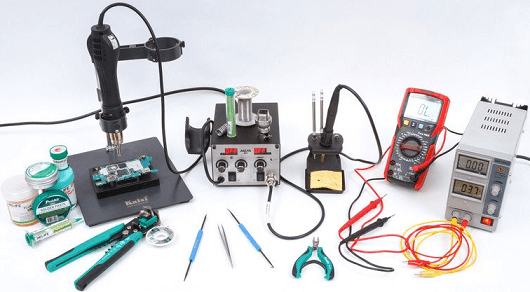In this guide, you will learn what soldering is, what you will need, safety measures, cleaning and maintenance techniques.
How to Solder? (Watch Video)
Introduction to Soldering
Soldering is the process through which two or more components can be joined together by melting a bit of metal, called as a filler or solder, at the joint. Once the melted solder cools down, it hardens and acts as a glue joining the components together.
How to use Solder Flux How to clean soldering iron Types of Soldering Soldering Fluxes Types
What Can You Solder?
The soldering technique was invented to join metals together. Noble metals such as gold, silver, tin, etc. offer stronger soldered bonds as compared to other metals because of their low reactivity and high melting points. However, noble metals are expensive and hence the most commonly used solder is an alloy made of 60% tin and 40% lead. The most difficult metals to solder are aluminum, high alloy and stainless steels, titanium and magnesium. These metals can be soldered with some pre-plating and pre-tinning. Soldering is usually used in the electronic industry to connect wires, fix broken circuits, repair radios, TV sets, antennas, etc. However, soldering can also be used to join plumbing, refrigeration components, and even jewelry!
Why Soldering?
Soldering is a technique to attach two components. Would you be better off with an adhesive or would it be best to solder? Find out with the following advantages.
Low Heat Impact: The solder is often at a lower melting point than the other components and hence is not impacted by the heat. Both Permanent and Temporary Joints: Once the solder hardens, it forms a very strong bond which is not breakable. However, it can be desoldered with no damage to the other components. Both temporary and permanent joints in one! Join Different Materials: Soldering can be used to join different metals as long as the solder has a lower melting point. Quick DIY: Soldering is easy to learn and can be mastered by anyone quickly. What’s more, it’s a very quick technique to join stuff together and is great for DIY projects.
What Tools Do You Need?
The following is a simple list of things that you will need for soldering projects.
Soldering Iron Solder Soldering Tip Soldering Station Soldering Stand Cleaning Pad Safety Glasses
Safety Precautions To Take
Soldering involves the use of extreme temperatures and toxic substances. Hence, safety should be prioritized during the soldering process. Here are some precautions to keep in mind.
Read all the instructions and guides of the equipment you are using Make sure you stay in a well-ventilated area Use safety glasses to prevent the fumes from getting into your eyes Don’t breathe in the fumes. If necessary, use a fumes extraction device Wash your hands after you are done Store away the equipment safely
How to Use a Soldering Iron?
Before Soldering
Now that you know the basics of soldering, here are some things you need to know before you solder. The first thing that you need to check is whether you have chosen the right tip for the job. Here’s a guide to selecting the right soldering iron tip. The next thing to check is whether the tip is clean. Many metals react with oxygen and form an oxidation layer. The oxidation layer on the soldering tip would reduce the efficiency of the heat transfer. To clean this, you will need to rub it against the cleaning pad. If it is very badly oxidized, then you might have to apply a tip reactivator. If the tip appears shiny after cleaning or re-activating, then you can take the next step – tinning. To ‘tin’ the tip, you have to coat it with a layer of solder. This prevents oxidation and improves heat transfer. Tin the tip immediately before and after soldering; you should also tin the tip after every two joints you solder. This will help in maintaining the longevity of the tip.
Step by Step Instruction Guide to Soldering
Desoldering
You may need to desolder to fix certain kinds of joints. Or you may have accidentally applied too much solder! Not to worry, you just need to reheat the iron to the required temperature and melt the solder. You can use a solder sucker, which looks like a syringe, to suck the excess solder. Another device you can use is a desoldering braid.
Finishing Up
Once you are done with the fixing, you will need to clean up and store your equipment away. All you need to do is use a cloth or metal wool to clean and tin the tip as mentioned before. Store it in a sealed container. Likewise, store the soldering iron in a sealed container to prevent oxidation and increase the life of the iron. We hope you liked this content. Stay tuned for more tips on electronics projects! Comment * Name * Email * Website
Δ






![]()